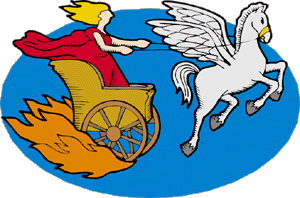What
are stories of origins?
 Ancient
cultures used stories of origins to help explain their heritage,
and the heritage of the world around them. In Exploring
Origins, the Genesis mission Web site explores
ideas about the origins of the solar system held by various
cultures throughout the ages. Let's look at how people have
used stories over the ages to celebrate their interaction
with me, the sun! Ancient
cultures used stories of origins to help explain their heritage,
and the heritage of the world around them. In Exploring
Origins, the Genesis mission Web site explores
ideas about the origins of the solar system held by various
cultures throughout the ages. Let's look at how people have
used stories over the ages to celebrate their interaction
with me, the sun!
 Stories,
history, myths, legends, are they all the same?
Stories,
history, myths, legends, are they all the same?
 We
know that different cultures over time described the sun based
on what was important to them. These relationships and perceptions
of the sun show us that people have always seen the sun as
important. The Genesis mission carries on this curiosity through
its exploration. If you made the study of mythology your life's
work, you would say that a myth
is a story from the past that interprets some aspect of the
world around us. Myths offer an explanation, interpretation,
or meaning. Althaea, the Greek goddess who gave birth to the
sun, is a myth. This is different from legends.
Legends are stories from the past about someone, some place,
or something that is believed to have been historical. They
attempt to offer factual information. Merlin, the magician
in King Arthur's court, is a legendary figure. We
know that different cultures over time described the sun based
on what was important to them. These relationships and perceptions
of the sun show us that people have always seen the sun as
important. The Genesis mission carries on this curiosity through
its exploration. If you made the study of mythology your life's
work, you would say that a myth
is a story from the past that interprets some aspect of the
world around us. Myths offer an explanation, interpretation,
or meaning. Althaea, the Greek goddess who gave birth to the
sun, is a myth. This is different from legends.
Legends are stories from the past about someone, some place,
or something that is believed to have been historical. They
attempt to offer factual information. Merlin, the magician
in King Arthur's court, is a legendary figure.
 Is
it all a matter of time? Is
it all a matter of time?
After
examining cultural artifacts, we know that people of long
ago tried to count the number of days to keep track of time
as it passed. Many ancient cultures explained the passing
of time with a myth. An early Egyptian myth is that the universe
is a rectangular box. The Earth is curved and sits at the
bottom of the box. The sky is the top of the box, and it is
supported by the peaks of four mountains located at the corners
of the flat Earth. A river flows around the Earth, and carries
the boat of the sun god-thus explaining the motion of the
sun. Thoth, an Egyptian god, is the measurer of time, and
is credited with devising our standard 365-day year. In early
Egypt, there apparently were no attempts (other than mythological)
to explain the motion of the heavenly bodies, even though
accurate observations were made.
The early
Greeks and Romans also relied on myths to interpret their
worlds. From myths came the beginnings of scientific explanations
for astronomical events with the Greeks. They thought that
the sky was a solid hemisphere, like a bowl. It covered the
flat Earth. A great river, Okeanos-the eldest of the Greek
Titans and the father of all rivers) encircled the shape of
the Earth.  The
sun traveled across the sky in a horse-drawn chariot. At night
the sun sailed in a golden bowl around the stream of Okeanos,
arriving just in time to rise the next morning. These early
cultural explanations occurred to meet some purpose. Today
we continue to find a purpose in nature and in our solar system. The
sun traveled across the sky in a horse-drawn chariot. At night
the sun sailed in a golden bowl around the stream of Okeanos,
arriving just in time to rise the next morning. These early
cultural explanations occurred to meet some purpose. Today
we continue to find a purpose in nature and in our solar system.
|
